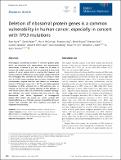Deletion of ribosomal protein genes is a common vulnerability in human cancer, especially in concert with
Author(s)
Ajore, Ram; Raiser, David; McConkey, Marie; Jöud, Magnus; Boidol, Bernd; Mar, Brenton; Saksena, Gordon; Weinstock, David M; Armstrong, Scott; Ellis, Steven R; Ebert, Benjamin L; Nilsson, Bjorn; ... Show more Show less
DownloadAjore-2017-Deletion of ribosomal protein genes.pdf (944.5Kb)
PUBLISHER_CC
Publisher with Creative Commons License
Creative Commons Attribution
Terms of use
Metadata
Show full item recordAbstract
Heterozygous inactivating mutations in ribosomal protein genes (RPGs) are associated with hematopoietic and developmental abnormalities, activation of p53, and altered risk of cancer in humans and model organisms. Here we performed a large‐scale analysis of cancer genome data to examine the frequency and selective pressure of RPG lesions across human cancers. We found that hemizygous RPG deletions are common, occurring in about 43% of 10,744 cancer specimens and cell lines. Consistent with p53‐dependent negative selection, such lesions are underrepresented in TP53‐intact tumors (P ≪ 10⁻¹⁰), and shRNA‐mediated knockdown of RPGs activated p53 in TP53‐wild‐type cells. In contrast, we did not see negative selection of RPG deletions in TP53‐mutant tumors. RPGs are conserved with respect to homozygous deletions, and shRNA screening data from 174 cell lines demonstrate that further suppression of hemizygously deleted RPGs inhibits cell growth. Our results establish RPG haploinsufficiency as a strikingly common vulnerability of human cancers that associates with TP53 mutations and could be targetable therapeutically.
Date issued
2017-03Department
Broad Institute of MIT and HarvardJournal
EMBO Molecular Medicine
Publisher
Wiley Blackwell
Citation
Ajore, Ram; Raiser, David; McConkey, Marie; J?ud, Magnus; Boidol, Bernd; Mar, Brenton; Saksena, Gordon et al. “Deletion of Ribosomal Protein Genes Is a Common Vulnerability in Human Cancer, Especially in Concert with TP53 Mutations.” EMBO Molecular Medicine 9, no. 4 (March 2017): 498–507 © 2017 The Authors
Version: Final published version
ISSN
1757-4676
1757-4684